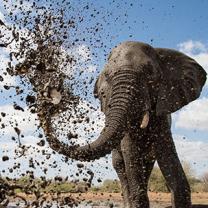Life at the Waterhole
Life at the Waterhole

-
Premiered:
- Network: PBS
- Category: Series
- Genre: Documentary
- Type: Live Action
- Concept:
- Subject Matter: Animal
- Tags:
Buy This Show on DVD or Watch Online
No DVDs Available
(That We Know Of)
(That We Know Of)
Legal Full Episodes
Not Available Online
(That We Know Of)
Not Available Online
(That We Know Of)
Plot Synopsis
Hosted by conservation scientist Dr. M. Sanjayan alongside wildlife cinematographer Bob Poole, LIFE AT THE WATERHOLE is a three-episode documentary series that explores the daily drama of African wildlife at a unique waterhole rigged with partially submerged and weather-proofed cameras in Tanzania. Waterholes are vital to the African ecosystem as bustling oases where elephants, lions, leopards and hundreds of other species meet and compete for water. The competition for existing resources has even led to human-animal conflict. Despite the growing fight for resources, little is known about how these waterholes support so much life. Working with Mwiba Wildlife Reserve and local communities in Tanzania, the team builds an artificial waterhole and outfit it with cameras. Within hours of construction, thirsty animals flock to drink, and the team uncovers the waterhole's complex dynamics for the first time. Filmed over three periods -- the middle of the dry season, the hottest time of year and the height of the first rains -- the series reveals dramatic interactions and unlikely rivalries, as well as some unexpected moments of humor. As elephants, warthogs, giraffes, monkeys and big cats jostle for position, scientists gain a greater understanding of the important role of water in Africa as its wildlife faces the growing impact of climate change. The three episodes include:
Episode 1 (Wednesday, May 19, 2021 at 8pm): The new waterhole is built in the middle of an open patch of savannah, enabling wildlife to approach from all directions. The team excavates 100 tons of soil, lays five miles of fiber optic cable and pumps in 13,000 gallons of sustainable groundwater. Within an hour, warthogs and elephants discover this new oasis, and soon a cast of wild animal characters keeps coming back. Dr. Sanjayan uncovers the surprising schedule of a day at the waterhole and uses state-of-the-art thermal cameras to record how different animals cool down to survive. As the landscape becomes drier, tensions rise between the two biggest drinkers: elephants and cape buffalo. Cameraman Bob Poole looks at the waterhole's effect on the wider landscape, including embarking on an adventurous nightime stakeout with Sanjayan to monitor the resident big cat population. As leopards and lions close in, the waterhole quickly becomes a dangerous place.
Episode 2 (Wednesday, May 26, 2021 at 8pm): As the weather heats up, the waterhole becomes busier in the cool of the evening. With remote cameras able to get within close proximity, the team uncovers the new nighttime dynamics. The shift to nocturnal activity brings a new predator out of the shadows: hyenas, creatures so elusive it is hard to know the size of the clan. Their arrival dramatically impacts other predators, and no lions or leopards are spotted while they are around. To discover more about the hyena clan, Dr. M. Sanjayan and wildlife cameraman Bob Poole head into the bush to rig remote cameras to monitor their nearby den. The waterhole is becoming an increasingly risky place for many herbivores, but new bird species continue to flock to the oasis. In an ambitious experiment, Dr. M. Sanjayan and scientist Dr. Meredith Palmer attempt to count the hyenas at night, discovering larger numbers than they ever imagined. As rain clouds gather, another dramatic change is on the horizon, and we meet a very special elephant.
Episode 3 (Wednesday, June 2, 2021 at 8pm): The rains begin to fall, and the area transforms into a lush grazing pasture. This time of year can be harder for predators as prey migrate further and temperatures are more moderate. Using remote cameras, Dr. M. Sanjayan and the team reveal how the hyena clan copes with these new circumstances. Cameraman Bob Poole catches up with some of the waterhole community that is now spread out across the landscape, looking for the freshest grass. With plenty of calories available, now is the time for many species like giraffes to mate. Back at the waterhole, Dr. Sanjayan uncovers a massive shift in the drinking schedule as a great migration of wildebeest heads towards Mwiba Wildlife Reserve. These grazing animals move en masse and require a lot of food and water. Will this put further pressure on the waterhole residents? As the rains continue, it's not just the landscape around the waterhole that changes. With food and water in abundance, it's birthing season for many herbivores. But how will an increase in population affect the area? At the end of the rainy season, Dr. Sanjayan delves into the data to discover how animals have used the waterhole across the past three seasons.
Cast
Production & Distribution
- Produced by BBC Natural History Unit
Settings
- - Tanzania
